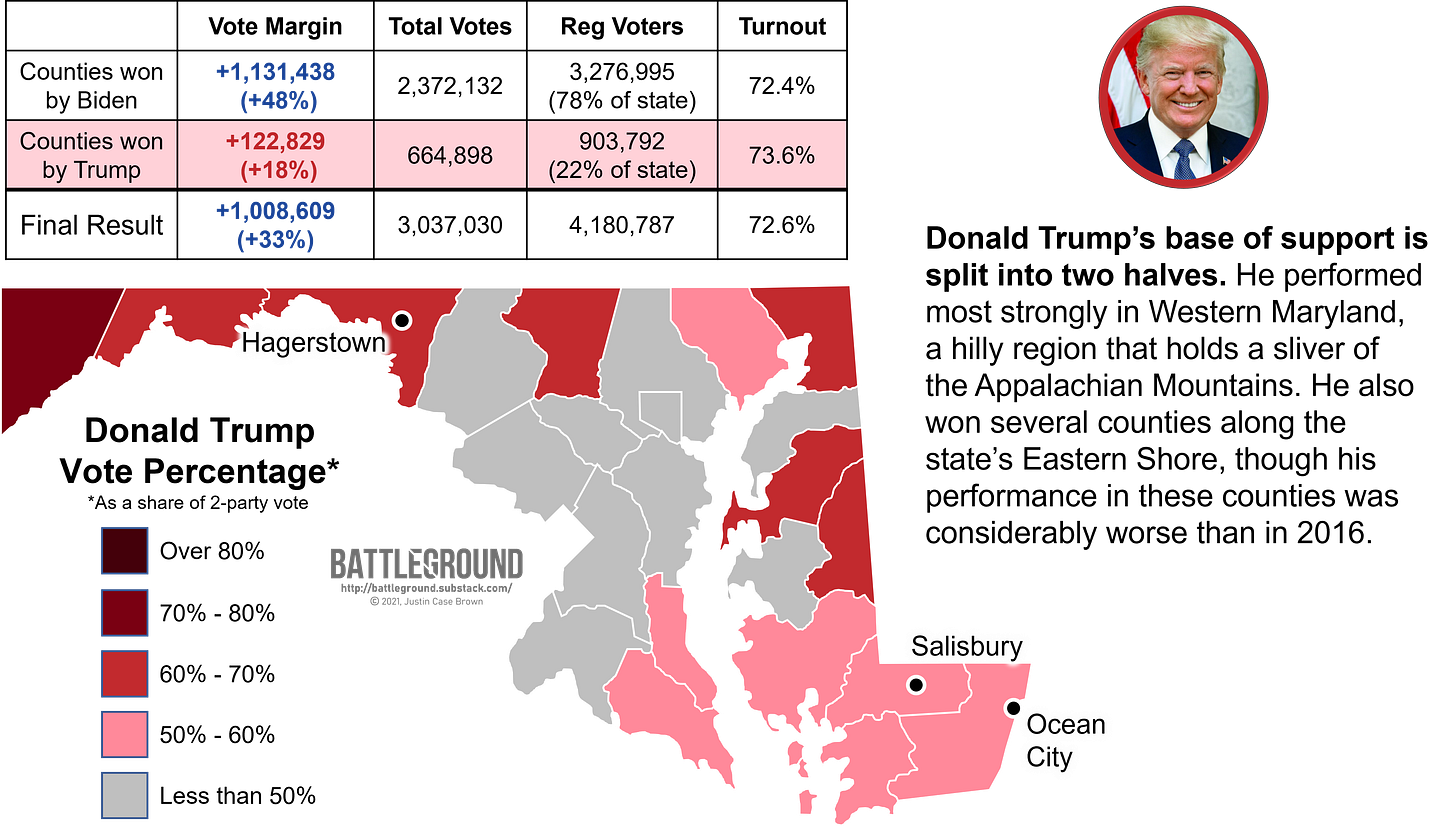Maryland: the Blue Heart vs. the Panhandles
With cities, mountains, beaches and farms, Maryland truly is "America in Miniature"
Topline Takeaways
Pres. Joe Biden performed even better than expected, increasing the margins in most counties when compared to Hillary Clinton’s campaign in 2016.
Donald Trump did best in Western Maryland and the Eastern Shore, areas that are sparsely populated and largely rely on agriculture.
Democratic success in the state is largely due to a mix of high educational attainment and an extremely diverse electorate.
In-Depth Insights
Joe Biden’s monumental success in Maryland proves the state’s continued status as a Democratic stronghold. In the 2016 election, Maryland only fell behind DC, California and Hawaii in its support for Hillary Clinton, giving her just over 60% of the vote statewide. Pres. Biden managed to push that high watermark even higher, running ahead of Clinton in just about every county in the state. The base of Democratic support lies in the center of the state surrounding Washington, DC and Baltimore and these voters makeup over 80% of the state’s voting base. Democratic strength is most often attributed to the state’s large African American population; almost 1 in 3 residents identify as such. When including other minority populations, the state stands as having the fifth-highest proportion of minorities in the country. This diverse coalition has largely rejected the race-baiting politics of Trumpism and only entertains moderate Republican candidates like current governor Larry Hogan who has repeatedly fought back against the former president.
Donald Trump’s base of support falls primarily into Maryland’s two panhandle regions whose geographies are incredibly different from one another. Western Maryland shares more in common with neighboring West Virginia than the rest of the state: the rugged terrain produced by the Appalachian Mountains keeps towns small and the economy focuses more on agriculture and less on information and technology like the rest of the state. The three counties that make up Western Maryland: Garrett, Allegany and Washington, are also a part of the Appalachian Regional Commission, a federal-state partnership that works to bring opportunity to those living in the mountainous region.
Meanwhile to the east of the Chesapeake Bay lies counties that are often dubbed the “Eastern Shore.” The land in this area is incredibly flat and is known best for its seafood, specifically the Chesapeake blue crab, widely considered a traditional Maryland culinary delicacy. Much of the Eastern Shore’s economy is based around agriculture, with grain farming and large-scale chicken breeding being popular in the area.
The primary similarities between the two panhandles are its low population density and low educational attainment relative to the rest of the state. Several counties in the blue heart of Maryland have as many as 66% of its residents holding a college degree. Conversely, much of the counties Trump won along the state’s edges have half that level of educational attainment; many holding less than 1-in-3 residents with a college degree.
Forecasting the Future: While a win for Joe Biden was practically preordained, the candidate performed even better than expected, flipping three largely rural counties: Frederick, Kent and Talbot. (Two of which hadn’t voted for a Democratic candidate since 1964.) To make matters worse for Republicans, more than half of the state’s counties moved toward Democrats by 5 or more points, proving that embracing Trumpism is a losing battle for Maryland Republicans.
While diversity and educational attainment are the primary engines for Democratic success in the state, it’s also important to acknowledge the influence of Washington DC on the surrounding areas. While some Maryland residents in the DC suburbs don’t have any direct connections to the federal government, most feel the second-order effects of government mismanagement and federal shutdowns, even moreso than residents in farther flung areas along the panhandles. Throughout Donald Trump’s time in office, Maryland residents were forced to endure constant threats of furloughs and looked on with disgust as Trump seemed incapable of understanding how to effectively run his administration. Despite the deep aversion to Trump, Governor Larry Hogan has proven that Republicans can carve a path to victory in the state, but that path involves forcefully standing up to Trump in ways that most in the party are unwilling to engage.






